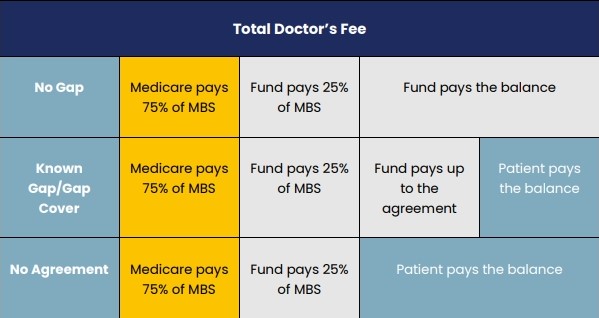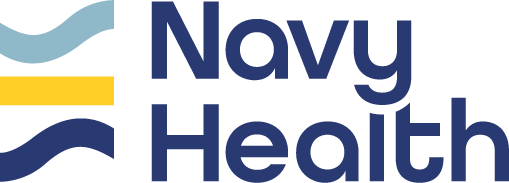Covering the Gap
Covering
the Gap
Navy Health Access Gap Cover Scheme
Going to Hospital can be a stressful time, so the last thing you or your family should need to worry about is excessive out of pocket expenses. This is where Navy Health’s Access Gap Cover scheme can assist.
Overview
Navy Health’s Access Gap Cover scheme aims to minimise the difference between the Medicare fee and what your Specialist charges. Specialists can choose to take part in Access Gap Cover on a case-by-case basis; if they take part you’ll either have no gap or be told exactly what your out-of-pocket costs will be. Even if your Specialist elects not to take part, you are legally entitled to know any out-of-pocket cost before your procedure – ask your Specialist.
What are out-of-pocket expenses?
The Australian Government sets a Medicare Benefits Schedule (MBS) fee for most services. Procedures recognised by Medicare will have a set MBS ’item number’ and fee. However, Specialists can charge their patients more than the MBS fee if they choose to do so. Medicare and Navy Health cover the cost of the MBS fee for in-hospital treatments but any extra amount charged by the provider becomes an out-of-pocket cost to you.
MBS fee breakdown:
- Medicare pays 75% of the MBS fee for in-hospital treatment as a private patient. Navy Health will pay the remaining 25% of the MBS fee.
- Medicare pays 85% of the MBS fee for out-of-hospital services. Australian Private Health Insurers are legally prohibited from, and cannot provide benefits for services provided out of hospital.
Example
Sally is going to hospital to receive treatment for Medicare item number 12345 which has a set MBS fee of $1000. However Sally’s Specialist, Dr Smith, will be charging $1200 to provide this treatment. In this instance, Medicare will pay $750 (75% of the MBS fee), Navy Health will pay $250 (the remaining 25% of the MBS fee) meaning Sally will have to pay Dr Smith the extra $200. This is Sally’s out of pocket expense.
How can I reduce my costs?
You can ask your Specialist if they will participate in Navy Health’s Access Gap Cover scheme. Our Access Gap Cover scheme allows us to provide benefits to our members to cover some or all of the gap.
Things to note:
- There is no requirement for any doctor to participate in Navy Health’s Access Gap Cover scheme;
- You should always ask Navy Health and your Specialist about your Access Gap Cover benefits before you are treated; and
- If there is going to be an amount left for you to pay, the Specialist is legally required to advise you of this before you agree to be treated, wherever practical. They will provide you with a breakdown of costs which will include how much is covered by Medicare and your private health insurance. This is called Informed Financial Consent.
There are 2 ways the Access Gap Cover scheme can work for you; Known Gap Scheme or No Gap Scheme.
Known Gap Scheme
If your chosen Specialist bills with a Known Gap through Access Gap Cover, your out-of-pocket expenses relating to your in-hospital treatment will be capped. You won’t be charged any additional amounts other than what you’ve agreed to in your Informed Financial Consent before your in-hospital treatment.
No Gap Scheme
If your chosen Specialist chooses to bill you with no gap, you will not have any out-of-pocket expenses for their in-hospital treatment.
Navy Health’s agreements are negotiated by the Australian Health Service Alliance (AHSA).
What if my Specialist does not participate or does not want to participate in the Access Gap Cover Scheme?
You have every right to use your current medical referral to shop around for a Specialist that does participate in the scheme. In this case we also encourage you to call Navy Health to discuss your treatment options.

To find Specialists that may participate in the Navy Health Access Gap scheme, go to healthshare.com.au.
Things to remember
- Ask your Specialist if they will participate in the Access Gap scheme prior to your procedure;
- Navy Health will only pay for services listed on your policy once you have served the applicable waiting periods;
- The Navy Health Access Gap scheme is only available for inpatient services (i.e. when you are admitted to hospital as a private patient);
- Navy Health has no control of the out-of-pocket expenses set by your Specialist if they are not participating in the Access Gap scheme; and
- It is entirely up to your treating Specialist whether they will participate in the Access Gap scheme or not.
Changes to the Access Gap Cover scheme from 1 July 2020
Currently, the Access Gap Cover scheme allows Specialists to charge a patient up to $400 for each Medicare item number that is used for treatment in hospital as a private patient. There can be multiple Medicare item numbers used during the procedure, depending on what the patient is being treated for.
A Specialist could also charge a patient a booking or administration fee not associated with the Medicare item number.
Effective 1 July 2020, the maximum an individual Specialist can charge under the Access Gap Cover scheme is $500, per admission to hospital (as a private patient). Specialists can no longer charge fees not associated with the Medicare item number.
The changes apply to all Navy Health members that include hospital cover on their membership.
Frequently Asked Questions
What should I ask my Specialist?
Simply ask your Specialist if they will treat you under the Access Gap Cover (AGC) scheme.
If they agree, you will only pay up to $500 per Specialist per hospital stay (as a private patient) ($800 for obstetrics). They may even agree to charge ‘no gap’, which will means you will not have any additional out-of-pocket fees for their services.
Specialists can decide to participate in the AGC scheme on a case-by-case basis, they are not obliged to treat you under this scheme.
Simply ask your Specialist if they will treat you under the Access Gap Cover (AGC) scheme.
If they agree, you will only pay up to $500 per Specialist per hospital stay (as a private patient) ($800 for obstetrics). They may even agree to charge ‘no gap’, which will means you will not have any additional out-of-pocket fees for their services.
Specialists can decide to participate in the AGC scheme on a case-by-case basis, they are not obliged to treat you under this scheme.
What does ‘No Gap’ mean?
‘No Gap’ is where the provider charges the AGC amount with no additional charge to the patient.
‘No Gap’ is where the provider charges the AGC amount with no additional charge to the patient.
What is ‘Known Gap’?
‘Known Gap’ is where the Specialist can charge up to the maximum AGC amount, $500 per individual Specialist ($800 for obstetrics), so the patient has a gap (also known as the ‘out of pocket’).
It is called a ‘Known Gap’ because written Informed Financial Consent (IFC) is required under AGC prior to the procedure, which means the patient ‘knows about the gap’ before they receive their medical bill.
‘Known Gap’ is where the Specialist can charge up to the maximum AGC amount, $500 per individual Specialist ($800 for obstetrics), so the patient has a gap (also known as the ‘out of pocket’).
It is called a ‘Known Gap’ because written Informed Financial Consent (IFC) is required under AGC prior to the procedure, which means the patient ‘knows about the gap’ before they receive their medical bill.
What are additional fees?
If a provider chooses to use AGC, they cannot charge any ‘additional fees’ or hidden fees. These additional or hidden charges include booking fees, management fees, technology fees, administration fees and any other fees that are not a professional service described by the Medicare Benefits Schedule (MBS) item number.
If a provider chooses to use AGC, they cannot charge any ‘additional fees’ or hidden fees. These additional or hidden charges include booking fees, management fees, technology fees, administration fees and any other fees that are not a professional service described by the Medicare Benefits Schedule (MBS) item number.
What is a Medicare item number?
The Medicare Benefits Schedule (MBS) is a large listing of medical services covered and subsidised by the Australian government. Each service listed has its own fee, which is set by the Government. Whether you’ve got Private Health Insurance or are a private patient paying for all your own costs, the government provides a rebate on most medical services.
Your surgeon, anaesthetist and assistant surgeon can each bill their own MBS items for a hospital stay (where you are admitted as a private patient). Together, these MBS items provide a detailed hospital invoice and summary. Before any hospital admission utilising your private hospital cover, it’s a good idea to get an itemised quote of the MBS items applicable to your treatment – known as Informed Financial Consent.
Informed Financial Consent or the written estimate of fees should include:
The Medicare Benefits Schedule (MBS) is a large listing of medical services covered and subsidised by the Australian government. Each service listed has its own fee, which is set by the Government. Whether you’ve got Private Health Insurance or are a private patient paying for all your own costs, the government provides a rebate on most medical services.
Your surgeon, anaesthetist and assistant surgeon can each bill their own MBS items for a hospital stay (where you are admitted as a private patient). Together, these MBS items provide a detailed hospital invoice and summary. Before any hospital admission utilising your private hospital cover, it’s a good idea to get an itemised quote of the MBS items applicable to your treatment – known as Informed Financial Consent.
Informed Financial Consent or the written estimate of fees should include:
- Details of the proposed procedure including hospital, admission date, procedure details such as MBS items with a description and fee for each;
- Other services or Specialists such as anaesthetist, assistant surgeon, pathologist or radiologist and their fee estimate;
- Medical Devices and Human Tissue Products that may be required and their fee, plus the health fund benefit; and
- Patient or guardian signature and date, as a general acknowledgement of the fees.




